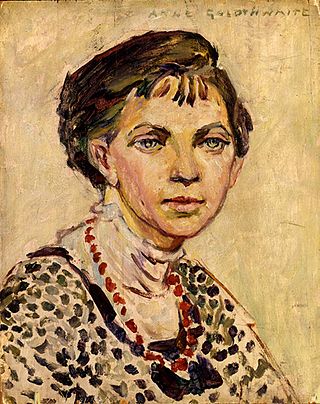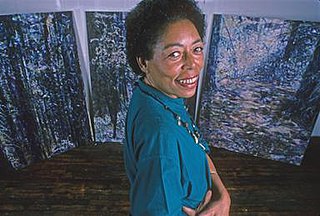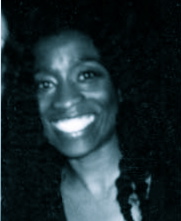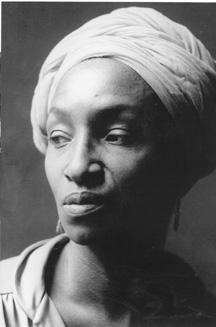
Aquatint is an intaglio printmaking technique, a variant of etching that produces areas of tone rather than lines. For this reason it has mostly been used in conjunction with etching, to give both lines and shaded tone. It has also been used historically to print in colour, both by printing with multiple plates in different colours, and by making monochrome prints that were then hand-coloured with watercolour.

Lorraine O'Grady was an American artist, writer, translator, and critic. Working in conceptual art and performance art that integrates photo and video installation, she explored the cultural construction of identity – particularly that of Black female subjectivity – as shaped by the experience of diaspora and hybridity. O'Grady studied at Wellesley College and the University of Iowa Writers' Workshop before becoming an artist at age forty-five. Regarding the purpose of art, O'Grady said in 2016: "I think art's first goal is to remind us that we are human, whatever that is. I suppose the politics in my art could be to remind us that we are all human."

Dorothea Rockburne is a Canadian abstract painter, drawing inspiration primarily from her deep interest in mathematics and astronomy. Her work is geometric and abstract, seemingly simple but very precise to reflect the mathematical concepts she strives to concretize. "I wanted very much to see the equations I was studying, so I started making them in my studio," she has said. "I was visually solving equations." Her attraction to Mannerism has also influenced her work.

Emma Amos was a postmodern African-American painter and printmaker.

Anne Goldthwaite was an American painter and printmaker and an advocate of women's rights and equal rights. Goldthwaite studied art in New York City. She then moved to Paris where she studied modern art, including Fauvism and Cubism, and became a member of a circle that included Gertrude Stein, Henri Matisse, and Pablo Picasso. She was a member of a group of artists that called themselves Académie Moderne and held annual exhibitions.
Sarah Brayer is an American artist who works in both Japan and the United States. She is internationally known for her poured washi paperworks, aquatint and woodblock prints. In 2013 Japan's Ministry of Culture awarded Sarah its Bunkacho Chokan Hyosho for dissemination of Japanese culture abroad through her creations in Echizen washi. She currently resides in Kyoto, Japan and New York, U.S.A.
"Where We At" Black Women Artists, Inc. (WWA) was a collective of Black women artists affiliated with the Black Arts Movement of the 1960s and 1970s. It included artists such as Dindga McCannon, Kay Brown, Faith Ringgold, Carol Blank, Jerri Crooks, Charlotte Kâ (Richardson), and Gylbert Coker. Where We At was formed in the spring of 1971, in the wake of an exhibition of the same name organized by 14 Black women artists at the Acts of Art Gallery in Greenwich Village. Themes such as the unity of the Black family, Black female independence and embodiment, Black male-female relationships, contemporary social conditions, and African traditions were central to the work of the WWA artists. The group was intended to serve as a source of empowerment for African-American women, providing a means for them to control their self-representation and to explore issues of Black women's sensibility and aesthetics. Like AfriCobra, a Chicago-based Black Arts group, the WWA was active in fostering art within the African-American community and used it as a tool of awareness and liberation. The group organized workshops in schools, jails and prisons, hospitals, and cultural centers, as well as art classes for youth in their communities.

Dindga McCannon is an African-American artist, fiber artist, muralist, teacher, author, and illustrator. She co-founded the collective Where We At, Black Women Artists in 1971.
Maren Hassinger is an African-American artist and educator whose career spans four decades. Hassinger uses sculpture, film, dance, performance art, and public art to explore the relationship between the natural world and industrial materials. She incorporates everyday materials in her art, like wire rope, plastic bags, branches, dirt, newspaper, garbage, leaves, and cardboard boxes. Hassinger has stated that her work “focuses on elements, or even problems—social and environmental—that we all share, and in which we all have a stake…. I want it to be a humane and humanistic statement about our future together.”

Vivian E. Browne was an American artist. Born in Laurel, Florida, Browne was mostly known for her painting series called Little Men and her Africa series. She is also known for linking abstraction to nature in her tree paintings and in a series of abstract works made with layers of silk that were influenced by her travels to China. She was an activist, professor, and has received multiple awards for her work. According to her mother, Browne died at age 64 from bladder cancer.
Weusi Artist Collective is an organization of African-American artists, established in 1965, based in the Harlem section of New York City. Inspired by the Black Arts Movement, the members of the Weusi Artist Collective create art invoking African themes and symbols. The organization was a major driving force behind the development, production and dissemination of black art in the United States in the 1960s and 1970s.

Elaine "Jae" Jarrell is an American artist best known for her fashion designs and her involvement with the Black Arts Movement of the 1960s.

Alva Rogers is an American playwright, composer, actor, vocalist, and arts educator. She is known for the use of dolls and puppetry in interdisciplinary work. Rogers performed in the role of Eula Peazant in Julie Dash's 1991 film Daughters of the Dust. and was a vocalist in the New York City alternative rock band Band of Susans.
Barbara Jones-Hogu was an African-American artist best known for her work with the Organization of Black American Culture (OBAC) and for co-founding the artists' collective AfriCOBRA.

Ming Smith is an American photographer. She was the first African-American female photographer whose work was acquired by the Museum of Modern Art (MOMA) in New York City.
Carole Marie Byard was an American visual artist, illustrator, and photographer. She was an award-winning illustrator of children's books, and the recipient of a Caldecott Honor, as well as multiple Coretta Scott King Awards.

We Wanted a Revolution: Black Radical Women, 1965–85 was an exhibition held at the Brooklyn Museum of Art from April 21, 2017, through September 17, 2017 surveying the last twenty years of black female art. The exhibition was organized thematically, presenting forty artists and activists whose work was dedicated to the fight against racism, sexism, homophobia, and class injustice.
Ann Graves Tanksley is an American artist. Her mediums are representational oils, watercolor and printmaking. One of her most noteworthy bodies of work is a collection based on the writings of African-American novelist and anthropologist Zora Neale Hurston. The Hurston exhibition is a two hundred plus piece collection of monotypes and paintings. It toured the United States on and off from 1991 through 2010.
Rodeo Caldonia also known as Rodeo Caldonia High Fidelty Performance Theater was a black feminist arts collective based in Fort Greene, Brooklyn during the 1980s. The collective, which operated from about 1985-1988, included nearly 20 African American women who wanted to create feminist work that focused on their identities as Black women. The collective was founded by Lisa Jones and Alva Rogers.
Derin Young is an American cultural programmer, producer, songwriter, sound designer, and vocalist. She was a member of Rodeo Caldonia High Fidelity Performance Theater.











